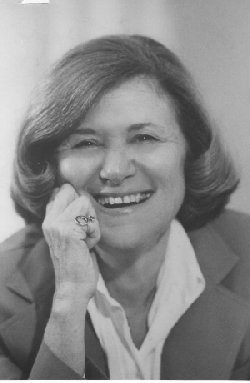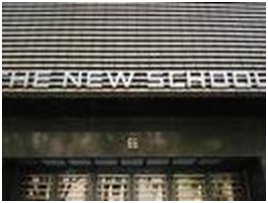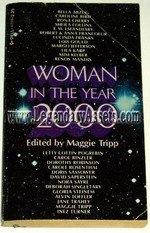|
MAGGIE TRIPP - LIVING LEGEND, ACCIDENTAL FEMINIST,
WOMEN STUDIES TEACHER, WRITER, LECTURER
 I was Born Female, but, of course,
I was not Born Feminist. I was Born Female, but, of course,
I was not Born Feminist.
Like other Philadelphia-born and bred girls, I expected to become a wife and mother; but, instinctively, I wanted
to explore what else I could be. And from childhood, I had a very independent mind. (In public school, my report
card was usually PP9. That's Poor for Conduct, Poor for Effort and "9" -- the best grade in the class.
( I was bored.)
The very idea of staying in Philadelphia for college drove me wild. I chose Barnard College in New York City; it
was the closest thing to a convent…one narrow bed, one dresser, a small desk and a set of rules on the back of
the door including front gates locked at nine p.m. to seal us from the men across the street at Columbia. I lasted
six weeks, then returned to Philadelphia, in time to make the January term at Penn. I went to Wisconsin and Cornell
for the next two summer sessions to catch up with my normal graduation date, the Class of '42.
But Penn didn't escape my boundary-breaking nature, either. Women in those days were automatically assigned to
Penn's College for Women. I wanted to learn about business. After a bit of a wrestling match with the powers that
used to be, I was admitted to classes at the Wharton School. As the only woman then at Wharton, I was called "ballsy
and aggressive," a title I publicly acknowledged years later when I was invited to return to Penn as the featured
speaker at the merger of the College for Women into the mainstream University of Pennsylvania.
Oh, yes, and did I mention I was married for a year and a half by graduation. time? It was obviously one of my
better decisions for we've now been wed more than seventy years. Alan has always helped me with my writing -- the
one thing I'll admit he does better than I do.
During World War II, I managed to have two children - Alan got home often - and took courses towards my Masters
in Art at Penn. But as soon as the war was over, I plunged into business ventures. Flowers-Every-Friday was a subscription
service. For three bucks a week, we'd deliver flowers of our choice to your house - the clever part was that we'd
go to the wholesale flower market at 5 a.m. and buy whatever was plentiful and cheap. The men who ran those wholesale
houses couldn't believe that two women (me and my partner, Doris Beifield) could sell and pay for so many flowers,
so it was all cash on the flower bed.
Tiring of rising at 5 a.m.. to deal with condescending men, I morphed to the art gallery business. Gallery 252
in center city Philadelphia was devoted to contemporary art and local artists, some quite excellent, though hardly
famous. I learned the truth about big time art when I took some paintings by best young artist to New York and
urged Leo Castelli, the dean of art dealers, to give this kid a break. Leo Castelli told me, "My dear, he's
quite good. But so are dozens of other young artists I've seen. And, you see, what my clients buy is my opinion
of my artists." I decided that, whatever I might do next, I wanted to be the arbiter.
Then, in 1966, to my surprise there came a request that moved my focus to academia. Ginny Henderson, the universally
respected Assistant Dean of the School of Women at Penn, called to say she had a grant from the Carnegie Foundation
to fund a course on "what women do with their lives." Ginny overcame my protestations of pedagogical
ignorance by putting me in a 30-day intensive training for teachers.
I taught that course, twice. What I saw was women wearing Peck & Peck suits who wanted to talk endlessly about
anything they might do -- but not really wanting to do anything. That was a clue. There was a lot of work to do
to change women's self-image.

That's when we moved to New York City. But I didn't leave Philadelphia far behind. Ginny Henderson and I conceived
and wrote a proposal for a book to show women how they could be in command of their lives. We titled it, "The
New Isabella." after the Spanish Queen who dominated her world. Dean Henderson sent me to the dean of literary
agents in New York, Carolyn Stagg, a wonderfully bright woman, then about 75 years old, who read the book proposal
and told me: "My dear, you're writing about quite modest goals for women. Go down to The New School in Greenwich
Village and catch up with the times."
And that's where feminism caught up with me.
I signed up at The New School for a class in women's rights. I was the only one in a dress, not jeans. The more
I listened, the more I knew how much I had been missing. It wasn't a question of fighting for an isolated justice
here or there. It was a movement, an uprising, a sea change in women's accepted roles.
To learn more about this new movement, I called the New York Women's Resource Center. I said to the woman who answered
the phone: "My name is Maggie Tripp and I've moved here from Philadelphia and I'm taking a class on Feminism
at the New School and I'm looking for more information on the subject." "Look," she said, "I
don't know what you're looking for but there are just two of us here. I'm Abortion and the only other one is Rape."
After a few months of investigating Feminism - with much more success than my first telephone call -- I told Ruth
Van Doren, head of the Women's Studies department at New School that I could teach a class called, "The Changing
Consciousness and Conscience of Women - Liberation How?"
Now the New School operates as a marketplace: people propose courses and, if the title and outline sound right,
the course gets listed in the New School catalog. Then, if enough people sign up to make the course profitable,
it gets a classroom and away you go. If not, you're cancelled. Well, women signed up in droves to find out how
to get liberated - and I figured out the lectures week-by-week.
"The Changing Consciousness…" lasted four semesters. As my own consciousness and horizons expanded, the
women's movement exploded and I was exposed to the minds of such socially intelligent people as Caroline Bird,
Gloria Steinem, Bella Abzug,, Margaret Meade, Jesse Bernard and so many more great women. I expanded the feminist
premise with courses on small topics like "The Present and Future World of Women." When New York University,
New School's Greenwich Village neighbor, wanted to engage with the growing women's movement, they borrowed a group
of us from the New School to do a year-long series of seminars.
 One fine day, Ruth Van Doren called
me and asked: "NOW wants someone to give a short talk to a meeting of the buyers for Federated Stores. Can
you do it? You know, tell 'em about how women and women's roles are changing. Of course, I said, "yes"
- without even asking what it would pay. (Turned out to be $50.) Then came the hard part. What do I say? What do
you tell a group of hard-nose retailers, mostly men, that they don't already know - something they'd accept --
about women? As always, I consulted my husband. He provided the winning opening lines: "Good morning, Buyers.
My subject today is how you can beat last year's numbers, week-by-week, month-by-month. Oh, and incidentally, I'm
going to mention a few things you may not know about how your women customers are changing." One fine day, Ruth Van Doren called
me and asked: "NOW wants someone to give a short talk to a meeting of the buyers for Federated Stores. Can
you do it? You know, tell 'em about how women and women's roles are changing. Of course, I said, "yes"
- without even asking what it would pay. (Turned out to be $50.) Then came the hard part. What do I say? What do
you tell a group of hard-nose retailers, mostly men, that they don't already know - something they'd accept --
about women? As always, I consulted my husband. He provided the winning opening lines: "Good morning, Buyers.
My subject today is how you can beat last year's numbers, week-by-week, month-by-month. Oh, and incidentally, I'm
going to mention a few things you may not know about how your women customers are changing."
Verbalizing my beliefs about free choice for women became a habit. And being at New School in the late Sixties
and Seventies was the right place to build a reputation. I became the Women's Studies Maven in Residence, being
quoted in newspapers and writing articles for magazines from the feminist journal, Aurora, to the plebian publication,
Modern Bride. In an interview, Long Island Newsday dubbed me, "The respected mouthpiece of the Women's Liberation
Movement."
Someone, I know not who, recommended me to Program Corporation of America, a leading Speakers Bureau and soon I
found myself delivering the feminist message to big gatherings of students at colleges across the country.
At Mt. Holyoke, it was "Money is as Beautiful as Roses." Wellesley got the message as "Legal Tender
Has No Gender." And in Green Bay, Wisconsin, albeit the home of the very masculine Green Bay Packers, they
really took the point when I said, "Take Charge of Your Life - and You'll Never Look Back in Anger."
By the mid-1970s, the world at large wanted to know about the feminist viewpoint. Program Corporation booked me
everywhere from Junior League meetings to the International Federation of Teachers and to self-improvement blow-outs
with Wayne Dyer. To my surprise, it paid well. But I also brought the message to women at the Lexington Avenue
YWCA in New York where lectures on women's changing role drew crowds and paid little.
Not all of the bookings were a pleasure. The prospect of freedom of choice for women worried some people, and no
one made a career of this fear more aggressively than Phyllis Schlafly. When Program Corporation asked me to debate
her in Kansas City on the Equal Rights Amendment, I leaped at the opportunity. Frankly, she dominated the debate.
But she had two things going for her. First, she stacked the audience with her followers who applauded on cue and
then seized the microphones for the Q. & A. Second, she tortured the truth, saying, in effect: "If you
get a job, your husband will leave you." But, afterwards, in radio interviews, I beat her because the men
who did the interviews gave me a clean shot at explaining what women really want. And the story in the next day's
Kansas City Star was more than kind to me and to feminism.

Nowadays, it seems everybody writes a book. But back in the 1970s, it wasn't so easy for an unknown author to find
a publisher.
I was blessed to know some authors in New York. Writer Leta Clark hooked me up with agent Elaine Markson who involved
Don Fine,, publisher of Arbor House Books, who loved my idea of asking each of the wonderful people who understood
feminism to write a chapter on how they foresaw women's lives.
Who were the contributors? To name but a few, Letty Cottin Pogrebin, Alvin Toffler, Margo Jefferson, Nora Sayre,
Lois Gould, and Lucinda Franks. The subjects ranged from women's impact on politics to a new balance of power in
business to equal joy in sexual relations. And, of course, the introduction plus a chapter called The Free Married
Woman plus editing it all were the work of one Maggie Tripp.
Don named the book, "Woman in the Year 2000." It was published in hardcover in 1974 and in paperback
in 1976. and 1978. And it's still around on Amazon.
Speaking of books, during my teaching years I had accumulated many hundreds of volumes about women and, when I
left New York in 1989, what was I to do with them? I had kept in close touch with Susan McGee Bailey and Jan Putnam
at the Wellesley Centers for Women who not only welcomed the gift but created the Maggie Tripp Library - which
I have happily supported ever since.
Besides teaching and writing I was on the Education Committee of NOW and active in the Political Caucus and represented
WEAL at the Houston, TX convention. And I always paid my dues to all those organizations -- until I just plain
retired. I am very pleased to be included in the encyclopedic volume, Feminists Who Changed America.
I'll celebrate my 91st birthday on July 7th. My husband is alive and well -- and writing this for me. I had two
children; my son's a musical electronics whiz and I lost my daughter to cancer two years ago. My three grandchildren
are, respectively, a male lawyer, a male engineer and a female doctor. My three great-grandchildren are two girls
and one boy who, no doubt, will grow up to benefit from my efforts to achieve sexual equality.
Comments to Jacqui Ceballos: jcvfa@aol.com
Back to VFA Fabulous Feminists
Table of Contents |
|